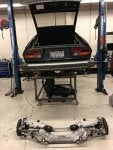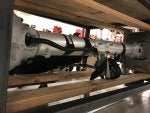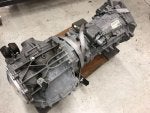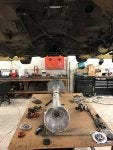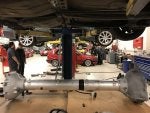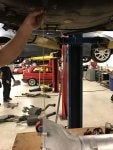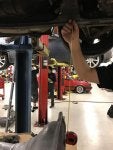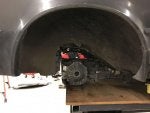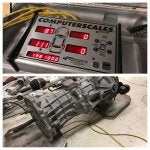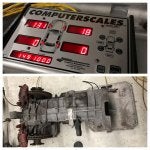We've now started the conversion and the initial findings look VERY promising!
Some (not so quick) history: When I converted my 3.7 Milano to a forward-mounted 6-speed Getrag transmission with a conventional rear-mounted differential arrangement from a Sedan (Alfa Sei), it was less about the STRENGTH of the box, or the strength of the internals, and much more about the QUALITY of the shifts!
After going through many-many standard gearboxes and having everything break from the LSD, to the side covers, to the clutch housing cover, to the stupid Italian-snot GUIBOS, I decided that living with the weak synchros was to be the final insult! Up until that point we had lightened the gears by cross-drilling and back-cutting, we tried lightened front flywheels, lightened rear flywheels, small-diameter clutch kits, shimmed-up LSD units; we tried EVERYTHING that you can on these Alfa boxes! We got them to shift better, but not perfect.
You get in my car now with that 6-speed Getrag (unit crosses over to the E90 / E92 / E93 V8 M3 box and several other European models), and you just shift it. You don't even think about it. Shift up. Shift down. Slow. Fast. Smile. Don't even think about it. Heel and toe. Double-clutch it - or don't. Slam it home, or go smooth. It really doesn't care, it just does its job like it should!
Yes, it was the effen syncros and the weak 1-2 up-shifts and 3-2 / 2-1 down-shifts that finally did it for me. That and serviceability. I can live with many things, but pulling transaxle Alfa boxes in and out is a soul-sucking job. Call it what it is. Add that to the weak peripheral design of components OTHER than the actual gears themselves (the LSD, the weak syncros, the case, the dumb 2-piece driveshaft, the rubber donuts etc.) and that's what it took for me to just say "no more"... :smile2:
I love my conversion. It was expensive and difficult, but I have never looked back. (Hell, all of the money spent on Alfa transaxles was just as expensive - not to mention the frustration!) To mention the turbo cars (with EXPENSIVE Colotti gear-stacks) as a comparison is ludicrous! Failing to mention works cars (without the context of legions of mechanics swapping boxes during and between races) is misleading. No one else in the US has ever run 400+ horsepower through one of these transaxles, so to reference a fix that will only work MARGINALLY on a modified standard bore 12 valve power-plant is not realistic.
The OP asked about a Corvette transaxle solution for a "high horsepower" GTV6, and that's what we should be talking about! We have started the conversion on a GTV6... Here are some pictures of the initial disassembly and eyeball work! We'll first address the big question of weight!



